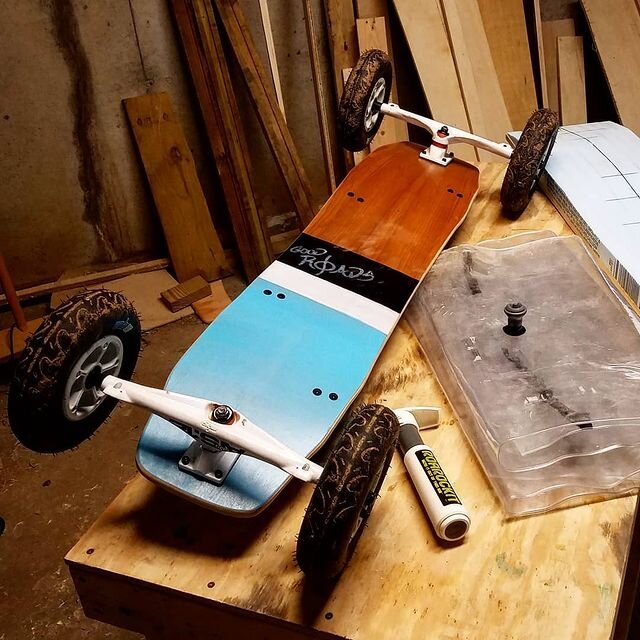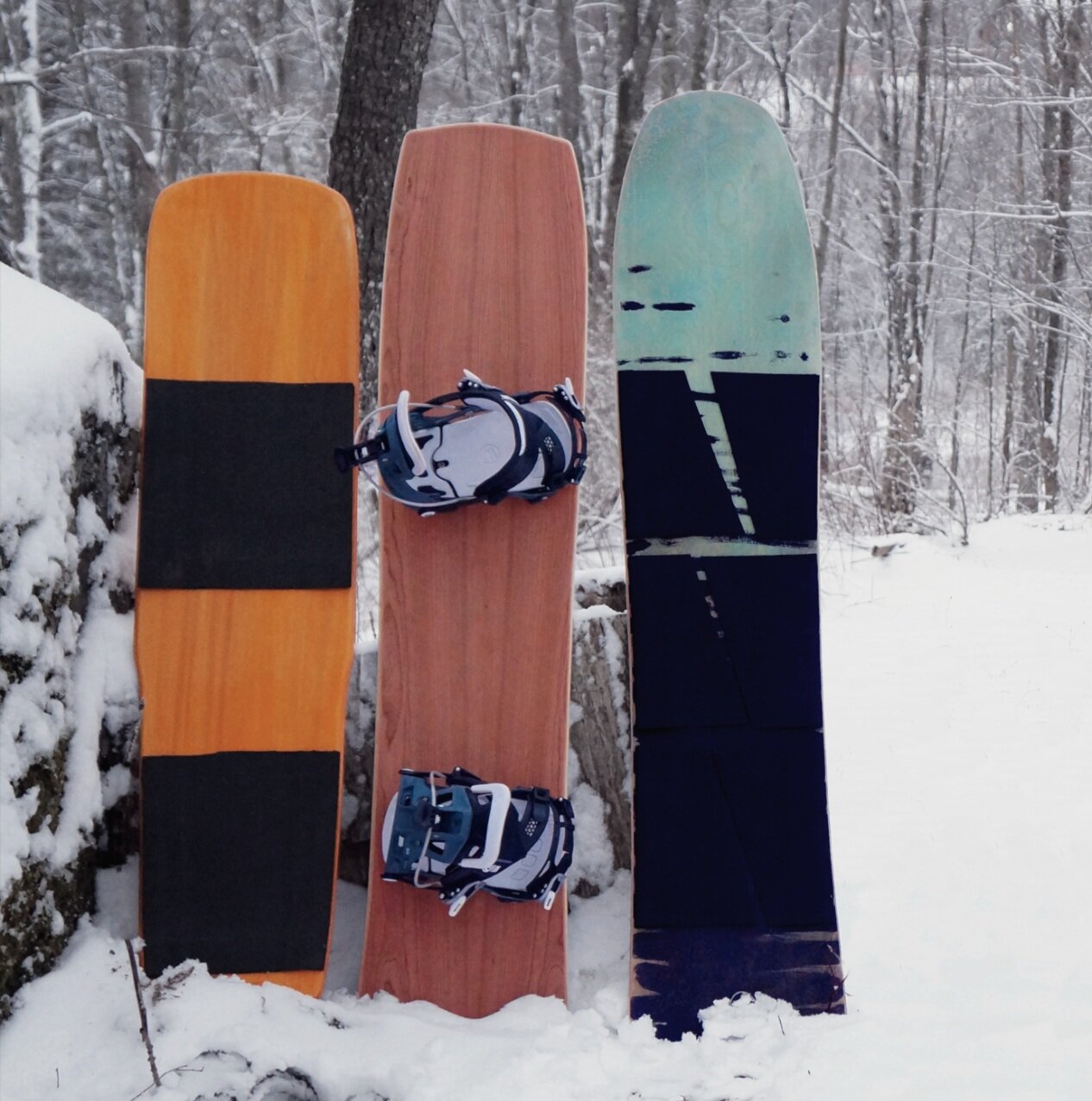Hi Chris, how are you today? Can you tell me a little about yourself and Good Roads?
Hey there! I’m doing well, we got about six inches of snow last night, so I’m looking forward to doing some snowboarding in this lovely winter weather.
I’ve been riding boards of all kinds since I was a kid. I’m passionate about making things so it was inevitable that I’d eventually end up building boards. My professional background is design. I got a B.S. in Graphic Design and a minor in Sculpture, and I worked in the digital side of the industry for about 12 years before shifting my focus to Good Roads. Now I’m applying everything I’ve learned as a professional designer and hobbyist board builder to both try to make really fun, likeable boards, and to try to get other people inspired to make boards of their own. Making and riding your own gear is so rewarding and joyful and I’m hoping that I can share that feeling with all different kinds of riders.
What got you into building boards? How long have you been building?
I’ve always been into making things, and when I get excited about something I tend to want to try making it myself. My mom is an art teacher and my dad is a general contractor so I grew up in a house with a real DIY ethos. I’ve been tinkering with and modifying my boards ever since I was a kid, but I got started pressing decks in college, which would be about thirteen years ago. I found the silverfishlongboarding.com board building forum and pressed my first set of decks in my living room. It’s been a pretty wild ride from that first board to where I am now.
Do you skate? How long have you been skating?
I do! Poorly though, hahaha! I picked up skateboarding at eleven, then got into snowboarding and mountainboarding, and skating sort of went by the wayside for a while. When I moved to Philly for school in 2005 there weren’t really any good mountainboarding spots local to where I was so I started longboarding. I’ve been longboarding pretty consistently since then, though I still mostly just cruise, and I’ve recently been able to pick mountainboarding back up which I’m really happy about.
What inspires you to create your boards?
A lot of things. I’ve still got that same desire where if I think something is cool I just have to make it. When it comes to boards, that means different geometries, different styles of decks, boards for different types of riding. And now that I feel like my skate and longboard building chops are up to snuff I’ve been venturing out into the other board sports I love, and trying my hand at building mountainboards and snowboards as well.
Learning and teaching have also become really powerful motivators for me. The unofficial mission statement of Good Roads is to inspire people to make their own gear, so I do a lot of builds that I think are easy or accessible. I’m hoping to show people that the barrier to entry is really low and that it doesn’t take much to get started building boards. On the other hand, I'm still learning too. Tackling challenges like the DIY wheel project or the snowboard build requires that I learn so many new techniques and start developing new skills, and that’s a really big part of the draw for me. Growing my capabilities.
How do you use Roarockit products in the making of your work? How did you find out about us?
I’m pretty sure I saw you guys get your start back on the ‘fish. I distinctly remember the original clamps you were using, the nested set of plastic pipes? So I’ve been following you for at least that long.
There are a lot of advantages to a Roarockit bag. Prototyping is a huge one. The one-sided foam mold is probably the easiest, cheapest, and fastest way to try out a shape. And because the material costs are so low, if the shape doesn’t work out then I’ve got no qualms about tossing the mold and moving on to the next one. I also like using them for composite builds--I think they handle glasses and other cloths well.
Additionally, for my audience, your vac bags are essentially a pre-fab press and probably the easiest way to get started pressing decks out of veneers (instead of birch plywood or similar materials). Since I’m hoping to get people building boards, Roarockit is such an easy resource to point aspiring shapers towards for materials and equipment. Whether the builder is a hobbyist or looking to eventually scale up to a production shop, I think the bags are a good step in anyone’s board building journey.
We love your Youtube channel! Tell us about how you got started making videos on Youtube?
I wanted to share the work I was doing. The vast majority of what I know about making boards I learned from resources like the now-defunct Silverfish forums. I got to watch a ton of super talented builders explore different techniques, share their R&D, and even start their companies. It was inspiring and taught me so much and sadly those resources don’t really exist any more. There are some good Facebook groups and other online communities, but the format of those communities doesn’t archive the projects in a way that lets you go back through and learn from them. Much of what I’m trying to do on Youtube is just taking all that board building knowledge I’ve ferreted away and repackaging it in a way that’s easy to access so that other builders can have some of the same resources I did. Lately I’ve been doing some innovation of my own, and I feel like it’s important to me to share that too. I want to pay it forward, and I also just enjoy having a community around the craft. Ideas can’t get discussed if they’re hidden in the dark.
We see that you make other board adjacent projects too! It's so cool that you have developed your own way of making wheels and bushings at home. What types of other projects do you do and what do you have planned for the future?
Trucks! Trucks trucks trucks. If 2020 was the year I learned to cast urethane then I want 2021 to be the year I learn to cast aluminum. I’m also continuing to develop my wheel and bushing techniques. I'm working on some new mold designs that I hope will require less post-processing and will be easier to use. I want to expand the capabilities of my shop so that I can start doing runs of decks instead of one-offs and that’s a bigger project than I would have expected, both in terms of tooling and in the skillsets I have to develop. I need to build a set of machines to test different urethanes that are available to hobbyists so that we can find some good, off-the-shelf materials for DIY wheels and bushings. I’ve got a bunch of other ideas bouncing around too. I haven’t committed to all of them yet, but it’s all fun board sport stuff. I feel like there’s so much to do!
What made you decide to make your experimentation and knowledge open-source and available for others to use and build on? What are your thoughts on the board building community?
I’m hoping it will kick-start a new cohort of builders and help spur innovation in the industry. Especially with the urethane projects. The cost of getting a new wheel design cast the traditional way can feel pretty astronomical--the tooling alone can cost thousands of dollars. By 3D-printing the molds you can get the cost of developing a new wheel down to a couple hundred bucks, and that’s if you don’t already have the printer.
I’m not going to invent the next great wheel. I’m not a skilled enough rider to understand the nuances of what makes a wheel truly excellent. But if I make these inexpensive techniques I’m developing open source, if I make them available to the community, then it opens the door for a whole bunch of talented, passionate riders to get out there and make their dream parts. Maybe start their own companies. That means more R&D in the sport, more options available in the market, more specificity and exploration into what these boards we ride are capable of, and to me that means everyone wins. Plus I get a bunch of new shaper friends to hang out with and nerd out about board building which is awesome.
Any advice for aspiring board builders out there?
Be tenacious. You are going to fail. You’re going to have boards de-lam, you’re going to make shapes that don’t work the way you want, you’re going to have layups go sideways, your router is going to destroy so many skateboards before you learn how to use it right. I might be projecting a little on that last one, but here's the point: you’re not alone. Everyone fails. It sucks to fail, it’s no fun at all, but the only way to get better, the only way to make that board you’re dreaming of, is to stick with it. I’ve been pressing decks for more than a decade and while I’ve made a bunch of good boards, I’ve also made a lot of junk, and I’ve only made three that I truly loved. And those three made everything else SO worth it. So don’t get discouraged, failure is part of the process, it’s part of learning and growing as a shaper. Your dream deck is out there waiting, don’t stop pushing until you get there.
If people wanted to find out more about your work, where can they see your creations and contact you?
I document all the projects I tackle over on Youtube, I’ve got some open source designs and also resource lists (and a couple tools for sale) at goodroadscollective.com, and you can hit me up on Instagram or by email (chris@goodroadscollective.com) to ask me questions about board building any time!
Thanks again for your time Chris, any last words for the readers back home?
Have FUN! And go build some awesome boards.
Taryn O'Grady,
Roarockit Skateboard Company









